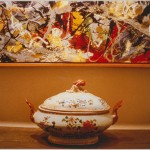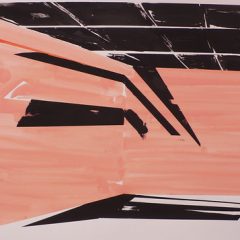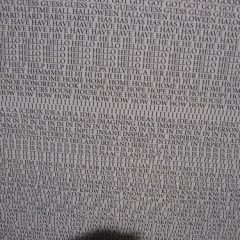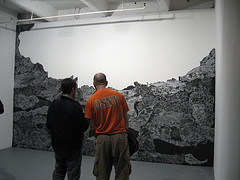
undead, by Amy Adams, and First Friday art lovers
I’ve seen three solo shows by Amy Adams at Vox Populi. The first show of hers and the current one blew me away.
Adams, 33, is the executive director at Vox, a woman who appears to have unlimited energy. That energy comes out in her work—an accumulation of marks or images that suggest plenitude and limitlessness as well as overload and vacancy. They’re works about a culture tailor-made for avid consumers, where everything amounts to nothing, and nothing amounts to everything.
I called her to ask some questions.
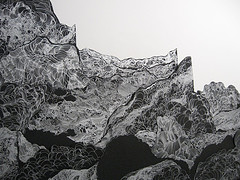
detail, undead
Libby: Silver appears often in your work. Why silver?
Amy: Whenever I’ve used silver in a painting, it has a smooth, perfect surface. It was silver that led me to the title [of the piece at Vox], undead. Silver is used to ward off vampires, zombies, the undead. I’m warding off the death of my art career.
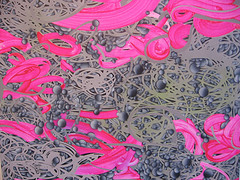
a previous Adams piece that used silver
Libby: Are you thinking of abandoning art?
Amy: No. I’m trying to find a way to work. I’m so busy now [working at] Vox, Esther Klein Gallery and freelance.
Painting is time consuming. It’s all about the materials. I’ve never shown or made drawings before. These are sort of my doodles writ large. I could come home at 7, I could sit with my dog and my boyfriend, and I didn’t have to ignore the rest of my life [while drawing].
Getting back to silver, there’s something precious about it. It adds gravity to those marks, which are not very special marks.
Libby: You are making landscapes. Not just in this large piece on the wall, but also your circle paintings are never-ending terrain. Can you talk about that?
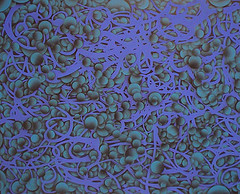
everythingBLUE, which touches on themes of consumerism and emptiness
Amy: The themes in all my work are accumulation, making something out of nothing, using simple shapes and materials. In the process of accumulation, a sort of terrain emerges from the individual decisions. The marks are stand-ins for all activity, and they add up to something greater. The accumulation of these actions is really what defines a life story. You go through life and make individual decisions that add up to who you are.
I also like the macrocosm/microcosm perspective. I sort of think about that as a parallel to current issues, for example, communication distance on the internet–it’s both really close and really far, a place where you can explore larger issues and also read what someone had for breakfast on their blog. Landscape is a perfect analogy.
(This is part 1 of a two-part interview. Here’s part 2)


